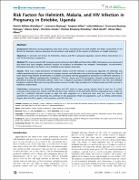| dc.contributor.author | Ndibazza, Juliet | |
| dc.contributor.author | Bazanya, Proscovia Namujju | |
| dc.contributor.author | Kizza, Moses | |
| dc.contributor.author | Ameke, Christine | |
| dc.contributor.author | Omoding, Nicolas Emojong | |
| dc.contributor.author | Booth, Mark | |
| dc.contributor.author | Elliott, Alison Mary | |
| dc.contributor.author | Woodburn, Patrick William | |
| dc.contributor.author | Muhangi, Lawrence | |
| dc.contributor.author | Hillier, Stephen | |
| dc.date.accessioned | 2019-02-14T11:33:39Z | |
| dc.date.available | 2019-02-14T11:33:39Z | |
| dc.date.issued | 2009 | |
| dc.identifier.citation | Ndibazza, J. et al. (2009). Risk Factors for Helminth, Malaria, and HIV Infection in Pregnancy in Entebbe, Uganda. Uganda Martyrs University, Nkozi: Uganda Martyrs University. | en_US |
| dc.identifier.uri | http://hdl.handle.net/20.500.12280/1361 | |
| dc.description.abstract | factors for infections informs planning of interventions and analysis of the impact of infections on health outcomes.To describe risk factors for helminths, malaria and HIV in pregnant Ugandan women before intervention in a
trial of de-worming in pregnancy. The trial recruited 2,507 pregnant women between April 2003 and November 2005. Participants were interviewed
and blood and stool samples obtained; location of residence at enrolment was mapped. Demographic, socioeconomic,
behavioral and other risk factors were modelled using logistic regression.
Results: There was a high prevalence of helminth, malaria and HIV infection, as previously reported. All helminths and
malaria parasitemia were more common in younger women, and education was protective against every infection. Place of
birth and/or tribe affected all helminths in a pattern consistent with the geographical distribution of helminth infections in
Uganda. Four different geohelminths (hookworm, Trichuris, Ascaris and Trichostrongylus) showed a downwards trend in
prevalence during the enrolment period. There was a negative association between hookworm and HIV, and between
hookworm and low CD4 count among HIV-positive women. Locally, high prevalence of schistosomiasis and HIV occurred in
lakeshore communities.
Conclusions: Interventions for helminths, malaria and HIV need to target young women both in and out of school.
Antenatal interventions for malaria and HIV infection must continue to be promoted. Women originating from a high risk
area for a helminth infection remain at high risk after migration to a lower-risk area, and vice versa, but overall,
geohelminths seem to be becoming less common in this population. High risk populations, such as fishing communities,
require directed effort against schistosomiasis and HIV infection. | en_US |
| dc.language.iso | en | en_US |
| dc.publisher | Uganda Martyrs University | en_US |
| dc.subject | Risk Factors | en_US |
| dc.subject | Helminth | en_US |
| dc.subject | Malaria & HIV Infection | en_US |
| dc.subject | Pregnancy | en_US |
| dc.subject | Entebbe, Uganda | en_US |
| dc.title | Risk Factors for Helminth, Malaria, and HIV Infection in Pregnancy in Entebbe, Uganda | en_US |
| dc.type | Article | en_US |


